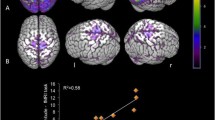Abstract.
The relationship between functional MRI (fMRI)-measured brain signal and muscle force and or electromyogram (EMG) is critical in interpreting fMRI data and understanding the control mechanisms of voluntary motor actions. We designed a system that could record joint force and surface EMG online with fMRI data. High-quality force and EMG data were obtained while maintaining the quality of the fMRI brain images. Using this system, we determined the relationship between fMRI-measured brain activation and handgrip force and between fMRI-measured brain signal and EMG of extrinsic finger muscles. Ten volunteers participated in the experiments (only seven subjects' data were analyzed due to excessive noise in the fMRI data of three subjects). The participants exerted 20%, 35%, 50%, 65%, and 80% of the maximal force. During each contraction period, handgrip force, surface EMG of the finger flexor and extensor muscles, and fMRI brain images were acquired. The degree of muscle activation (force and EMG) was directly proportional to the amplitude of the brain signal determined by fMRI in the entire brain and in a number of motor function-related cortical fields, including primary motor, sensory regions, supplementary motor area, premotor, prefrontal, parietal and cingulate cortices, and cerebellum. All the examined brain areas demonstrated a similar relationship between the fMRI signal and force. A stronger fMRI signal during higher force indicates that more cortical output neurons and/or interneurons may participate in generating descending commands and/or processing additional sensory information. The similarity in the relationship between muscle output and fMRI signal in the cortical regions suggests that correlated or networked activation among a number of cortical fields may be necessary for controlling precise static force of finger muscles.
Similar content being viewed by others
Author information
Authors and Affiliations
Additional information
Electronic Publication
Rights and permissions
About this article
Cite this article
Dai, T.H., Liu, J.Z., Sahgal, V. et al. Relationship between muscle output and functional MRI-measured brain activation. Exp Brain Res 140, 290–300 (2001). https://doi.org/10.1007/s002210100815
Received:
Accepted:
Issue Date:
DOI: https://doi.org/10.1007/s002210100815




